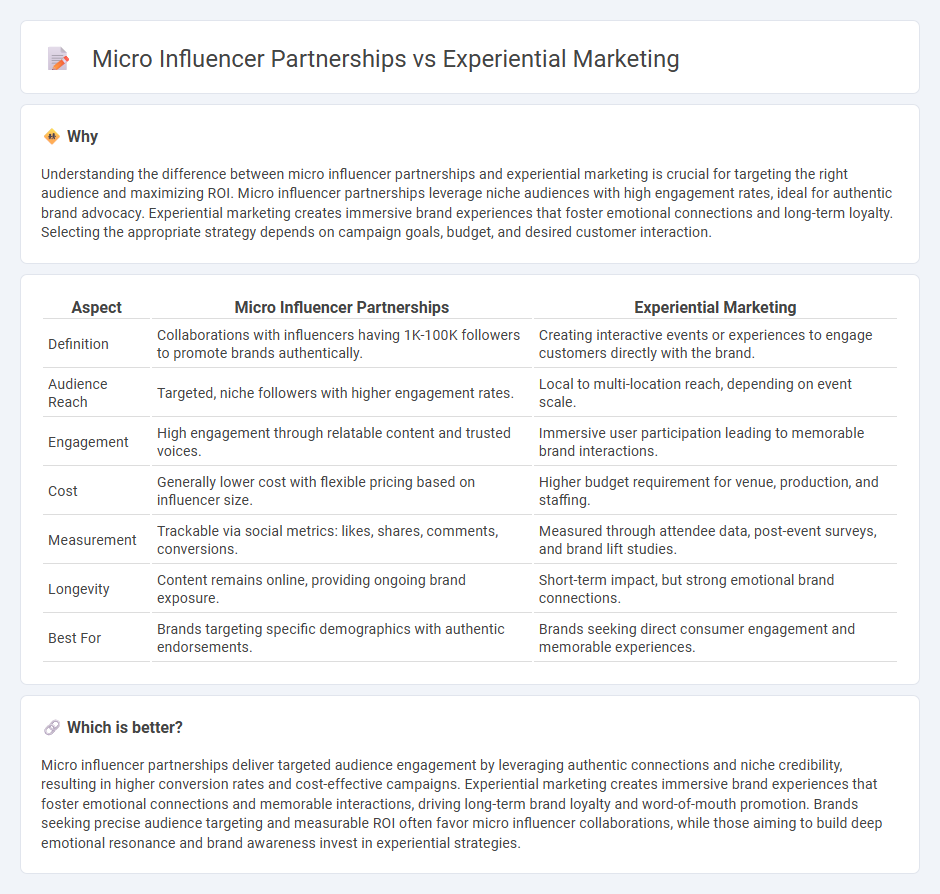
Micro influencer partnerships leverage niche audiences with authentic content creation, resulting in higher engagement rates and targeted brand exposure. Experiential marketing focuses on creating immersive brand experiences that foster emotional connections and long-lasting memories among consumers. Explore how combining these strategies can amplify your marketing impact and drive meaningful customer interactions.
Why it is important
Understanding the difference between micro influencer partnerships and experiential marketing is crucial for targeting the right audience and maximizing ROI. Micro influencer partnerships leverage niche audiences with high engagement rates, ideal for authentic brand advocacy. Experiential marketing creates immersive brand experiences that foster emotional connections and long-term loyalty. Selecting the appropriate strategy depends on campaign goals, budget, and desired customer interaction.
Comparison Table
| Aspect | Micro Influencer Partnerships | Experiential Marketing |
|---|---|---|
| Definition | Collaborations with influencers having 1K-100K followers to promote brands authentically. | Creating interactive events or experiences to engage customers directly with the brand. |
| Audience Reach | Targeted, niche followers with higher engagement rates. | Local to multi-location reach, depending on event scale. |
| Engagement | High engagement through relatable content and trusted voices. | Immersive user participation leading to memorable brand interactions. |
| Cost | Generally lower cost with flexible pricing based on influencer size. | Higher budget requirement for venue, production, and staffing. |
| Measurement | Trackable via social metrics: likes, shares, comments, conversions. | Measured through attendee data, post-event surveys, and brand lift studies. |
| Longevity | Content remains online, providing ongoing brand exposure. | Short-term impact, but strong emotional brand connections. |
| Best For | Brands targeting specific demographics with authentic endorsements. | Brands seeking direct consumer engagement and memorable experiences. |
Which is better?
Micro influencer partnerships deliver targeted audience engagement by leveraging authentic connections and niche credibility, resulting in higher conversion rates and cost-effective campaigns. Experiential marketing creates immersive brand experiences that foster emotional connections and memorable interactions, driving long-term brand loyalty and word-of-mouth promotion. Brands seeking precise audience targeting and measurable ROI often favor micro influencer collaborations, while those aiming to build deep emotional resonance and brand awareness invest in experiential strategies.
Connection
Micro influencer partnerships amplify experiential marketing by delivering authentic, relatable content that resonates with niche audiences. These collaborations create immersive brand experiences shared through social media, increasing engagement and brand trust. Leveraging the credibility of micro influencers enhances the emotional impact and reach of experiential campaigns.
Key Terms
**Experiential Marketing:**
Experiential marketing creates immersive brand experiences that engage consumers directly, fostering emotional connections and lasting impressions through interactive events, pop-ups, and brand activations. This approach drives higher brand recall and boosts word-of-mouth by transforming passive audiences into active participants. Explore how experiential marketing can elevate your brand engagement to new heights.
Brand Activation
Experiential marketing creates immersive brand activation through live events, sensory engagement, and interactive experiences, driving powerful emotional connections with consumers. Micro influencer partnerships leverage authentic content and targeted audiences to amplify brand messages and foster trust within niche communities. Explore how these strategies can synergize to maximize brand activation impact and customer loyalty.
Immersive Engagement
Experiential marketing creates immersive brand experiences that deeply engage consumers through sensory and interactive events, fostering strong emotional connections and memorable impressions. Micro influencer partnerships leverage niche audiences and authentic content to drive targeted engagement and trust, often enhancing brand credibility within specific communities. Explore how combining immersive engagement strategies with micro influencer collaborations can maximize marketing impact and consumer loyalty.
Source and External Links
Experiential Marketing: Creating Lasting Audience Connections - Bevy - Experiential marketing immerses customers in a brand's world by engaging all five senses to create memorable, interactive experiences that build lasting relationships and brand loyalty.
What is experiential marketing? Definition and examples - Amazon Advertising - Experiential marketing connects brands with consumers through in-person and digital experiences like pop-up stores and interactive events, emphasizing memorable and measurable engagement beyond traditional ads.
What is experiential marketing: Definition, why it works & examples - Xola - This strategy creates emotional connections through tangible, sensory-rich experiences that enhance brand perception, increase customer engagement, and drive higher ROI compared to static ads.
 dowidth.com
dowidth.com